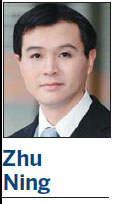A step in the right direction
Updated: 2013-06-28 10:26
By Zhu Ning (China Daily)
|
|||||||||||

Interest rate reform is a painful but necessary step for sustaining economic growth in China
The unexpected spike in the Shanghai Inter-bank Offered Rate does not appear alarming as such increases are normally seen towards the end of each month or quarter. The SHIBOR fluctuations are normally fueled by the banks' motivation to boost their savings level and achieve their savings quotas. However, what sets this increase apart from previous experiences is how the central bank has handled the cash squeeze.
According to official statistics, the inter-bank overnight rate and repo rate reached an astonishingly high level of 13 percent in June. The intra-day price reached 30 percent in intra-day trading on June 20, dwarfing even some of the shadow banking lending rates.
Based on traditional thinking, one would expect that whenever there is a cash squeeze or credit crunch, the central bank would release liquidity to calm the market. Especially so, as maintaining stability in the SHIBOR market is partly and implicitly the central bank's responsibility.
However, the People's Bank of China, China's central bank, surprised the market by not only not releasing the much-needed liquidity, but also by not repeating the earlier practices of injecting huge amounts of credit into the economy in a bid to appease the market and stimulate the economy.
Market disappointment at the central bank stance became evident when the Chinese A-share market took a hammering. After losing 5 percent on June 24, Chinese A-shares lost another 5 percent during intraday trading on the next day, before recovering most of the intraday losses.
Despite the outcries from capital market investors, the central bank seems to have stuck to its stance.
Given that the new government is willing to tolerate a lower growth rate and fundamentally shift the economic growth model, it is clear that the central bank will not continue its endless liquidity injections and instead will focus more on deflating the perceived bubbles in certain segments of the economy. With an eye on the speed of economic growth, the central bank also seems to be more concerned with the systematic and contingency risks that are likely to jeopardize long-term economic growth in China.
Though it appears to be a necessary yet difficult transition, there are underlying reasons for the central bank's actions. The burgeoning speed of economic growth the past few years has not necessarily been encouraging, and as some experts have pointed out, may indeed be a concern for China. After all, an economic growth model that relies too much on infrastructure investment, government stimulus and the real estate sector, cannot be sustained in the long run.
However, given that banks and other financial institutions, in particular trust companies, have got used to the unrealistically high returns in the past few years from the so-called shadow banking businesses, it is not that easy for these institutions to understand the lingering economic risks.
Certain prices may have to be paid and certain casualties may occur. Though the inter-bank rates have receded from their astonishingly high levels, short-term borrowing costs among financial institutions will continue to stay at elevated levels for some time.
The cost of borrowing for local government investment vehicles and companies, particularly real estate development companies that heavily rely on shadow banking and banks' off-balance sheet businesses, will continue to remain high. There may be isolated cases of default or even bankruptcy during this transition process. State-owned enterprises and small and medium-sized enterprises will suffer as well, due to a scarcity of funds and an increase in borrowing costs.
However, three things are worth pointing out. First, despite the short-term spikes in the inter-bank rate, the systematic liquidity in China still remains excessive, even after an extended period of loose monetary policy and active fiscal policy. Given that China remains largely closed for transactions under the capital flow account, such liquidity naturally leads to bubble formation in many areas and also induces capital into speculative areas, which could further strengthen and propel the bubbles.
Second, the central bank's target is to restore the rationality in the interest rate, one of the most important production factors, yet one that is more or less market-determined. The inter-bank hikes in the past few days, despite their short-term damage to the investors, are essential in helping banks and investors more clearly appreciate the risks facing them, and the entire economy. Only when risks and the related financing costs are properly priced, will economic growth become balanced and sustainable.
Finally, to mitigate the Chinese economy's slowdown, the central bank now has a better arsenal than the old-fashioned method of endlessly printing money and creating inflation. By letting the market determine the proper price for risks and creditworthiness, the central bank is going in the right direction of further deregulating the interest rate and legitimizing private banking businesses.
The mismatches between underlying risks and creditworthiness of many entities indeed have created some rosy prospects over the past few years. Yet, to really make economic growth sustainable, further reforms have to happen and the process may not be as rosy as enjoying dollar bills falling from helicopters.
The author is faculty fellow at the International Center for Finance, Yale University; and deputy director of the Shanghai Advanced Institute of Finance, Shanghai Jiao Tong University. The views do not necessarily reflect those of China Daily.
(China Daily European Weekly 06/28/2013 page13)
Today's Top News
List of approved GM food clarified
ID checks for express deliveries in Guangdong
Govt to expand elderly care
University asks freshmen to sign suicide disclaimer
Tibet gears up for new climbing season
Media asked to promote Sino-Indian ties
Shots fired at Washington Navy Yard
Minimum growth rate set at 7%
Hot Topics
Lunar probe , China growth forecasts, Emission rules get tougher, China seen through 'colored lens', International board,
Editor's Picks

|

|

|

|

|

|





